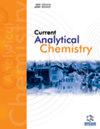吡唑并入噻二唑衍生物抗菌活性的硅学调查和分子对接研究
IF 1.7
4区 化学
Q3 CHEMISTRY, ANALYTICAL
引用次数: 0
摘要
背景:目前的研究设计了吡唑和噻二唑环系统的衍生物,并进行了对接研究以阐明其潜在的结合模式。抗菌药耐药性(AMR)是对全球公共卫生和发展的严重威胁,被世界卫生组织(WHO)列为全球十大风险之一。目标:目的是开发能有效针对多种耐药性微生物的新型抗菌药物。方法使用 AutoDock Vina 4 对设计的衍生物进行对接。2 与金黄色葡萄球菌 DHFR (2W9H)、金黄色葡萄球菌 GyrB (4URO)、金黄色葡萄球菌胸苷酸激酶 (4QGG) 的活性位点以及白色念珠菌 DHFR (1M78) 的活性位点进行对接、天冬氨酸蛋白酶 2 (3PVK)、白色念珠菌 N-肉豆蔻酰转移酶 (1IYK) 的抗真菌活性。结果:对所设计的衍生物的理化性质和药物亲和性进行了进一步的硅学评估。结论几种衍生物具有显著的抗微生物活性,其效力与标准药物环丙沙星和氟康唑相当。根据与受体活性位点的对接得分进行评估的结果表明,活性最强的 W36 和 W33 衍生物可能分别对 2W9H 和 1IYK 起到抗菌和抗真菌的作用。本文章由计算机程序翻译,如有差异,请以英文原文为准。
In silico Investigation and Molecular Docking Studies of Pyrazole Incorporated Thiadiazole Derivatives for Antimicrobial Activities
Background: In the current investigation, derivatives incorporating pyrazole and thiadiazole ring systems were designed, and docking studies were conducted to elucidate their potential binding mode. Antimicrobial Resistance (AMR) is a critical threat to global public health and development, recognized by the World Health Organization (WHO) as one of the top 10 risks worldwide. Objective: The objective was to develop new antimicrobial drugs that can effectively target a wide range of resistant microbes. Methods: The designed derivatives were docked using AutoDock Vina 4.2 against the active sites of Staphylococcus aureus DHFR (2W9H), Staphylococcus aureus GyrB (4URO), Staphylococcus aureus thymidylate kinase (4QGG) for antibacterial activity and Candida albicans DHFR (1M78), Candida albicans aspartic protease 2 (3PVK), Candida albicans N-myristoyl transferase (1IYK) for antifungal activity. Results: The designed derivatives underwent further assessment for in silico physicochemical properties, and drug-likeness. Conclusion: Several of the derivatives exhibited notable anti-microbial activity, demonstrating a potency on par with the Standard drug Ciprofloxacin and Fluconazole. The results, evaluated based on docking scores into the receptor's active site, suggested that the most active derivatives, W36 and W33, may act as promising antibacterial against 2W9H and antifungal against 1IYK, respectively.
求助全文
通过发布文献求助,成功后即可免费获取论文全文。
去求助
来源期刊

Current Analytical Chemistry
化学-分析化学
CiteScore
4.10
自引率
0.00%
发文量
90
审稿时长
9 months
期刊介绍:
Current Analytical Chemistry publishes full-length/mini reviews and original research articles on the most recent advances in analytical chemistry. All aspects of the field are represented, including analytical methodology, techniques, and instrumentation in both fundamental and applied research topics of interest to the broad readership of the journal. Current Analytical Chemistry strives to serve as an authoritative source of information in analytical chemistry and in related applications such as biochemical analysis, pharmaceutical research, quantitative biological imaging, novel sensors, and nanotechnology.
 求助内容:
求助内容: 应助结果提醒方式:
应助结果提醒方式:


